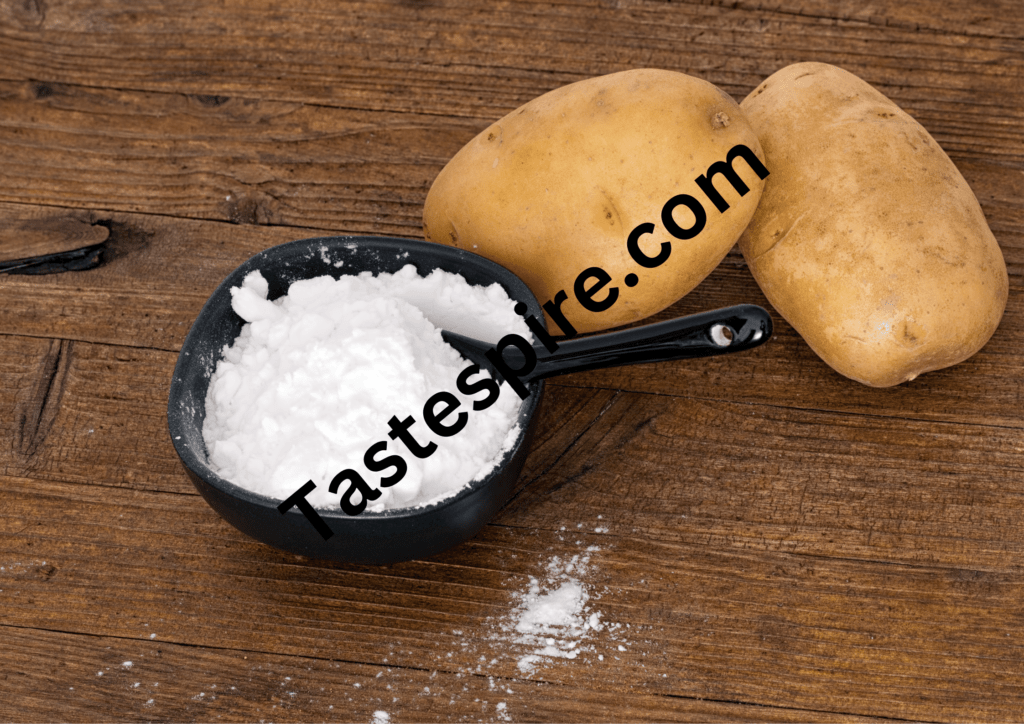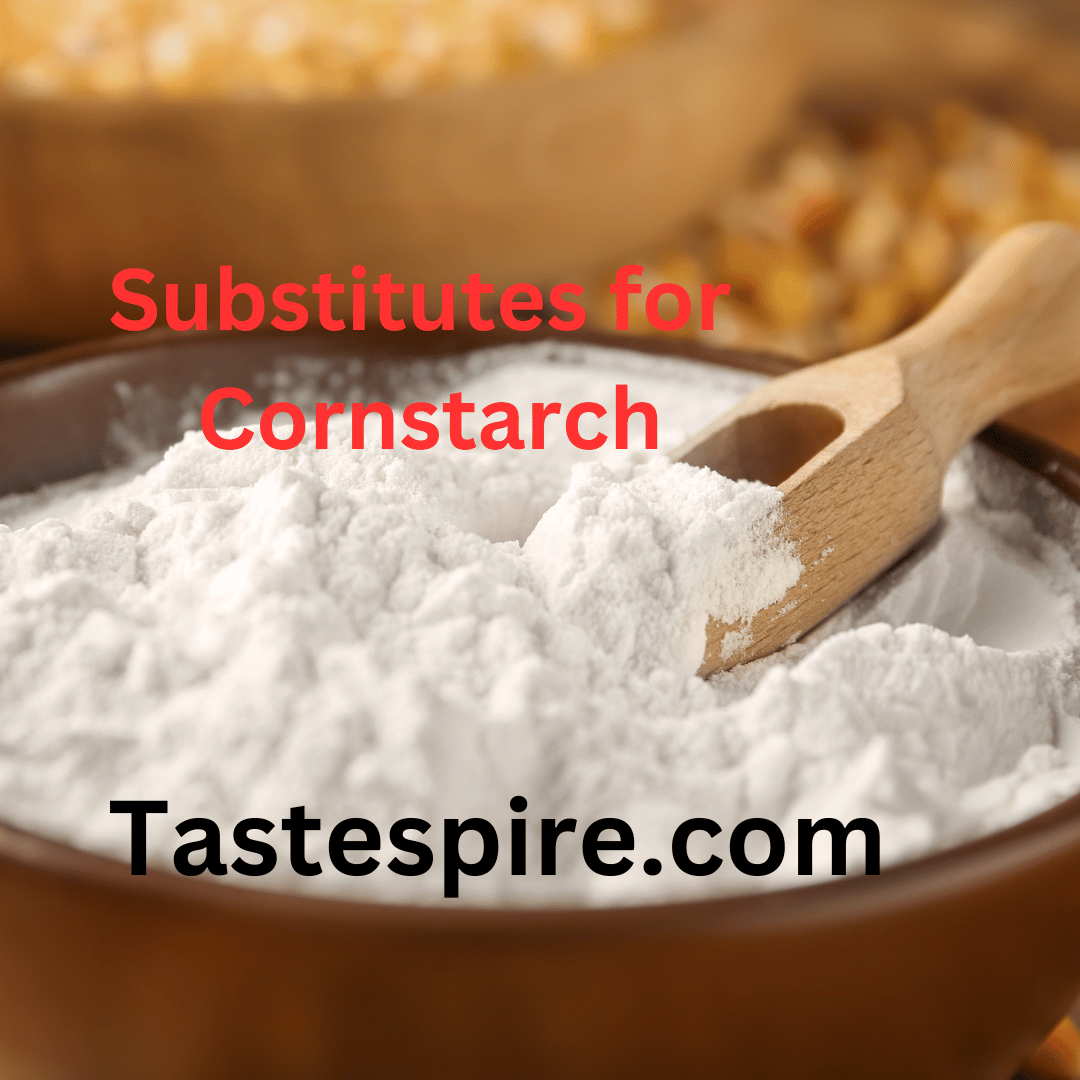Cooking is an art that relies heavily on experimentation and creativity. Whether you’re a seasoned chef or a home cook there are times when you run out of essential ingredients like cornstarch. Fear not as the culinary world is brimming with alternatives that can save your recipe and even add unique flavors and textures to your dishes. In this article, we will unlock the magic of cooking by revealing 10 surprising substitutes for cornstarch and how to use them effectively.
Table of Contents
10 Surprising Substitutes for Cornstarch In Baking And Cooking
1. Arrowroot Powder

Arrowroot powder is a fantastic substitute for cornstarch. It’s a gluten-free and plant-based thickener derived from the root of the arrowroot plant. When used in cooking, it creates a glossy texture and works well in fruit-based sauces such as berry compotes. To substitute, use the same measurement as cornstarch in your recipe.
2. Potato Starch

Potato starch is another versatile alternative to cornstarch. It’s made from the starch extracted from potatoes and offers excellent thickening power. Use it in soups, stews, and gravies for a smooth, lump-free consistency. The general rule is to use a 1:1 ratio when replacing cornstarch with potato starch.
3. Tapioca Flour
Tapioca flour also known as tapioca starch is a common thickening agent in many cuisines. It’s extracted from the cassava root and is famous for its ability to create a glossy finish. Tapioca flour is perfect for pies, puddings, and fruit fillings. Use it in equal amounts as you would with cornstarch.
4. Rice Flour
Rice flour is a gluten-free option that can work wonders as a cornstarch substitute. It provides a subtle and neutral flavor which make it suitable for both sweet and savory dishes. It’s a great choice for Asian-inspired sauces and can be used in a 1:1 ratio as a replacement for cornstarch.
5. All-Purpose Flour
In a pinch, you can turn to all-purpose flour as a substitute for cornstarch. While it may not yield the same glossy finish it does an excellent job of thickening gravies, sauces, and soups. To replace cornstarch use twice the amount of all-purpose flour.
6. Xanthan Gum
Xanthan gum is a powerful thickening agent and stabilizer often used in gluten-free cooking. It’s incredibly efficient, so you only need a small amount to thicken your dishes. For every teaspoon of cornstarch required, use a quarter teaspoon of xanthan gum.
7. Guar Gum
Guar gum derived from guar beans is another gluten-free thickening agent that can replace cornstarch effectively. It’s commonly used in ice creams, sauces, and dressings. Use it in a 1:1 ratio as a cornstarch substitute.
8. Ground Flaxseeds

Ground flaxseeds are an unconventional yet healthy alternative to cornstarch. They add a nutty flavor and extra nutrients to your recipes. To replace cornstarch, mix one tablespoon of ground flaxseeds with three tablespoons of water and let it sit for a few minutes until it thickens.
9. Gelatin
Gelatin is an excellent substitute for cornstarch in dessert recipes. It provides a jelly-like consistency, making it ideal for custards, puddings, and gummies. For every tablespoon of cornstarch, use one and a half teaspoons of gelatin.
10. Coconut Milk
For those looking to add a hint of tropical flavor coconut milk can be a delightful cornstarch substitute. It’s perfect for thickening curries, soups, and desserts while infusing a rich coconut essence. Substitute cornstarch with an equal amount of coconut milk.
What To Use Instead Of Cornstarch For Thickening?
When you need to thicken a sauce, soup, or any culinary creation and don’t have cornstarch on hand there are several alternatives you can use:
- Arrowroot Powder: Arrowroot is an excellent substitute for cornstarch. It thickens effectively and it’s almost flavorless which make it suitable for various dishes.
- Tapioca Starch: Tapioca starch is a great option for thickening sauces especially fruit-based ones. It provides a glossy finish to your dishes.
- Potato Starch: Potato starch is a versatile thickener that works well in soups, stews, and creamy sauces. It imparts a silky texture to your dishes.
- Rice Flour: Rice flour is a suitable replacement for cornstarch in both sweet and savory recipes. It’s particularly common in Asian cooking.
- Wheat Flour: All-purpose flour can also be used to thicken sauces and gravies. It’s a common item found in the majority of household pantries.
- Xanthan Gum: Xanthan gum is an effective gluten-free thickening agent especially in small quantities. It performs effectively in both dishes served at hot temperatures and those served at lower temperatures.
- Guar Gum: Similar to xanthan gum, guar gum is gluten-free and can be used as a thickener in various recipes.
- Corn Flour: Corn flour is often confused with cornstarch but it’s a distinct product that can be used as a thickening agent in sauces, gravies, and custards.
- Gelatin: Gelatin is a unique option that provides a different texture. It’s great for setting custards, puddings, and desserts.
- Coconut Milk Powder: For a tropical twist in your dishes, coconut milk powder can thicken while adding a subtle coconut flavor.
- Pureed Vegetables: For a natural and healthy thickening method you can puree vegetables like potatoes, cauliflower, or carrots and add them to your dish.
- Reduction: Sometimes, simply simmering your dish for an extended period can reduce excess liquid and naturally thicken it.
Each of these substitutes has its own unique characteristics and works well in specific situations. The choice depends on your recipe and dietary preferences.
FAQs
What can I use if I don’t have cornstarch?
If you don’t have cornstarch, you can use several alternatives depending on your recipe. Some common substitutes include arrowroot powder, tapioca starch, potato starch, rice flour, wheat flour, xanthan gum, guar gum, corn flour, gelatin, and coconut milk powder.
Can I replace cornstarch with flour?
Yes, you can replace cornstarch with flour as a thickening agent. However, keep in mind that flour has a slightly different taste and may create a cloudier texture compared to cornstarch especially in sauces and gravies.
Can baking powder replace cornstarch?
No, baking powder cannot replace cornstarch as a thickening agent. Baking powder primarily contains a leavening agent (usually baking soda) and acidic components and is used to make baked goods rise, whereas cornstarch is used for thickening.
What is a substitute for cornstarch in pie filling?
For pie filling, you can use tapioca starch or arrowroot powder as substitutes for cornstarch. They work well to thicken fruit fillings without altering the flavor significantly.
What can I use as a substitute for cornstarch in recipes?
Depending on the recipe, you can use arrowroot powder, tapioca starch, potato starch, rice flour, wheat flour, xanthan gum, guar gum, corn flour, gelatin, or coconut milk powder as substitutes for cornstarch.
Are there any gluten-free alternatives to cornstarch?
Yes, several gluten-free alternatives to cornstarch include arrowroot powder, tapioca starch, potato starch, and rice flour.
Can I use flour instead of cornstarch as a thickening agent?
Yes, you can use flour as a thickening agent instead of cornstarch but be aware that it may alter the taste and appearance of your dish slightly. Flour is a suitable substitute for most recipes.
What are some common substitutes for cornstarch in Chinese cuisine?
In Chinese cuisine, common substitutes for cornstarch include potato starch, tapioca starch, and rice flour. These alternatives are used to thicken sauces, stir-fries and soups.
Are there any keto-friendly options to replace cornstarch?
Yes, if you’re following a keto diet you can use xanthan gum or guar gum as low-carb substitutes for cornstarch. These options are effective thickeners without adding many carbs.
How can I thicken sauces without using cornstarch?
To thicken sauces without cornstarch you can use alternatives like roux (flour and fat mixture), reduction (cooking the sauce to evaporate excess liquid), pureed vegetables, or cream-based thickeners.
What is the best substitute for cornstarch in baking?
The best substitute for cornstarch in baking depends on the recipe. For pies and fruit fillings, tapioca starch or arrowroot powder works well. For cakes and cookies you can use flour or almond flour as alternatives.
Can I use arrowroot powder instead of cornstarch?
Yes, you can use arrowroot powder as a substitute for cornstarch. It has similar thickening properties and is often used interchangeably in recipes.
What are the pros and cons of using tapioca starch as a cornstarch substitute?
Pros of using tapioca starch include its excellent thickening power and ability to create a glossy finish. However, it can sometimes make dishes too gooey if overused and it may impart a slight tapioca flavor to the food.
Are there any natural alternatives to cornstarch for thickening soups and gravies?
Yes, some natural alternatives for thickening soups and gravies include pureed vegetables (like potatoes or cauliflower), ground flaxseed, chia seeds or even simmering the mixture longer to reduce it naturally. These options offer thickening without relying on processed starches.
In conclusion, cooking is an adventurous journey filled with opportunities for innovation and creativity. When you find yourself without cornstarch, these 10 substitutes will come to your rescue, each offering its unique touch to your dishes. Remember to adjust the quantity based on your recipe’s requirements, and don’t be afraid to experiment. With these surprising substitutes, you’ll unlock the magic of cooking and elevate your culinary creations to new heights. Happy cooking!
